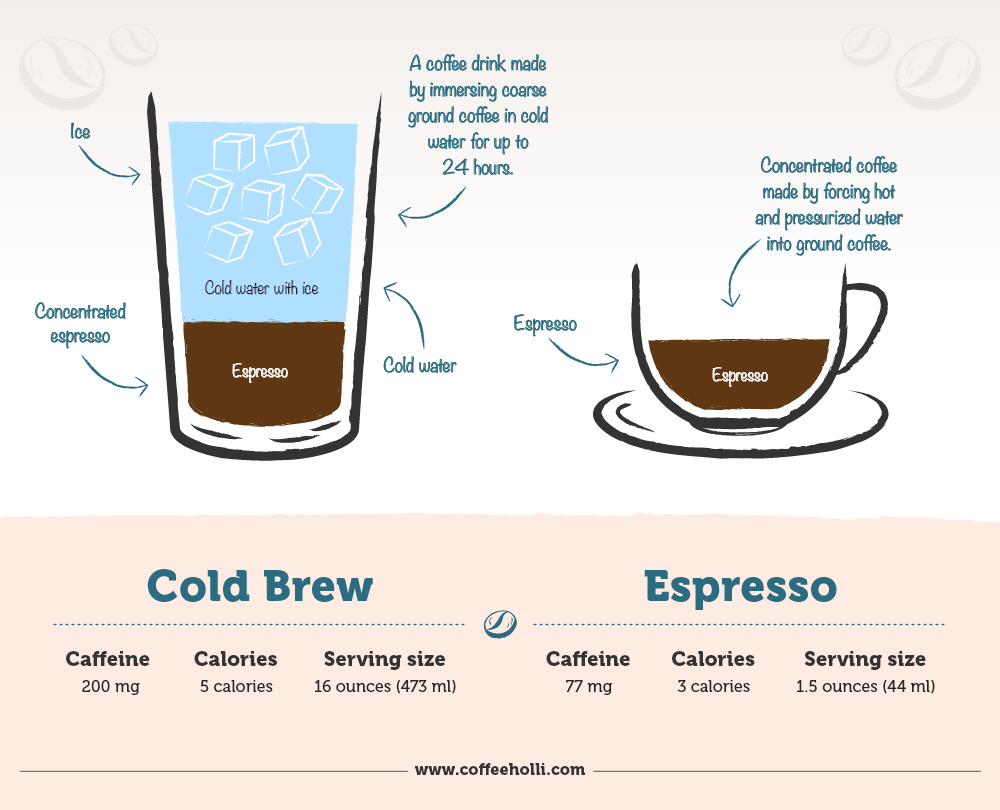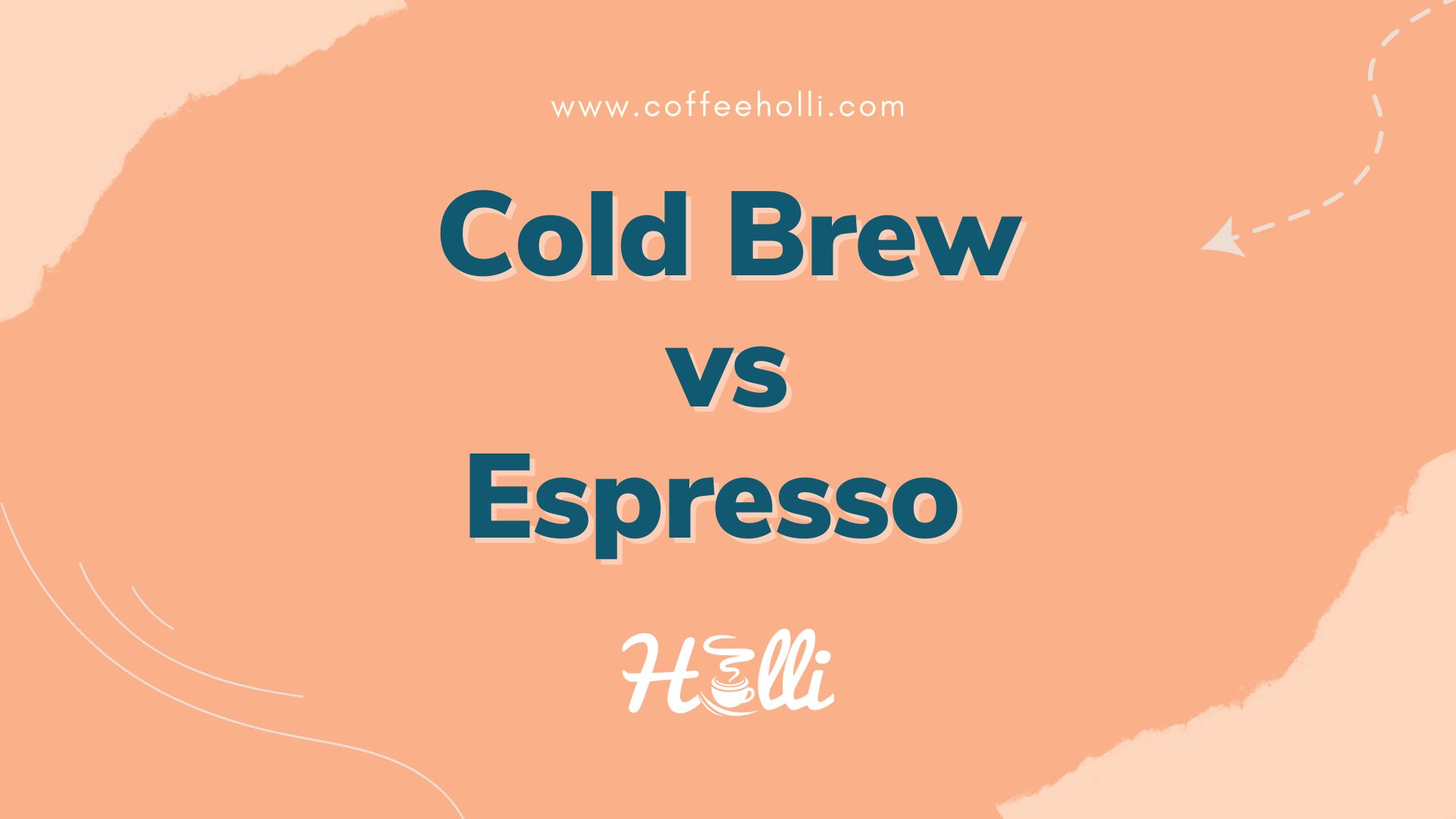
Now:
Coffee beans are not only rich in caffeine but also antioxidants, lipids, fats, melanoidins, fiber, and carbohydrates.
To extract these compounds, you can either brew ground coffee using water or eat them. Yes, eating a few coffee beans is safe.
When it comes to brewing, hot or cold water is used to extract all the soluble compounds.
And that is where coffee brewing methods such as Espresso, Cold Brew, Aeropress, Pour-over, and French press among others.
This post compares Espresso and Cold Brew coffee to find out how these two coffee drinks compare in terms of ingredients, preparation, and taste.
Without further ado, let’s get into it.
Table of Contents
Cold Brew vs. Espresso
A Cold Brew is made by steeping coarse ground coffee in cold water for 6 to 24 hours. On the other side, Espresso is made by forcing hot and pressurized hot water through super-fine ground coffee. Unlike Cold Brew, it takes 20-30 seconds to pull 1 shot of Espresso.
Because cold brew and espresso brewing methods are two completely different methods, the resulting drinks are also the same.
Below is a table comparing key aspects of a Cold Brew and Espresso.
| Cold Brew | Espresso | |
|---|---|---|
| Origin | Japan | Italy |
| Equipment | Container AeroPress French Press Cold Brew Coffee Maker | Semi-automatic, automatic, and super-automatic espresso machines |
| Grind size | Medium-coarse to coarse | Superfine |
| Roast profile | Light | Dark |
| Time | 6-24 hours | 20-30 seconds for 1 shot |
| Water ratio | 1:15 to 1:18 | 1:2 |
| Type of water | Cold filtered water | Hot filtered water |
| Serving size | 8-32 oz | 1-2 ounces |
| Caffeine | 8 oz = 100-250 mg | 1 shot = 63 mg |
| Serving temperature | Hot or Cold | Hot |
| Calories | <5 | <20 |
| Crema | No | Yes |
| Toppings | Liquid sweeteners | Sugar Whipped cream |
| Other uses | To make coffee cocktails | As a base for Espresso+milk drinks such as Latte, Cappuccino, and Flat White Among others |
| Taste | Less acidic. Slightly sweeter. Full-bodied. Smooth. | Balanced. Sweet. Acidic. Bitter |
5 Key Differences Between Cold Brew and Espresso
1. Origin
Now:
The origin of the Espresso drink dates back to 1905 when Luigi Bezzera and Desiderio Pavoni unveiled the first commercial Espresso machine, which they called cafe Espresso.
The name Espresso comes from the Italian name esprimere, which means to “press out”.
In the context of the espresso machine founders, the name means to brew coffee by forcing hot and pressurized water through ground coffee.
While there are several ways to make an espresso equivalent, you will need an espresso machine to make a true Espresso drink.
On the other side:
It’s not known exactly where the cold brewing coffee came from. Most accounts mention Japan, while others mention Peru and Guatemala.
Despite Cold Brew being centuries old, it was not until Starbucks started serving it that it became mainstream.
2. Process
Now:
Cold Brew and Espresso are made with the same coffee beans. It’s only that some coffee beans produce better Cold Brew. For instance, beans from lower elevation areas.
The major difference between the two brewing methods comes in roasting and grinding. Espresso is best made with dark roasted super-fine ground coffee.
The Cold Brew is best made with light roasted coarse ground coffee.
Why?
Since pulling a shot of Espresso takes 20 and 30 seconds, super-fine ground coffee provides a large surface for the hot water to quickly extract all the soluble compounds.
In the cold brew method, coffee and water are in contact for 6 to 24 hours. A coarse grind size ensures there is no over-extraction while allowing enough longer time for the extraction.
Cold Brew is done using cold water at room temperature. Cold water extracts some compounds that hot water does extract.
After brewing time is over, the ground coffee is filtered out. The drink is then drunk immediately or stored in the refrigerator for up to 2 weeks.
Some people heat Cold Brew before drinking, while others add a wide range of toppings. Cold Brew is also used to make coffee cocktails.
While there are now cold brew coffee makers, cold brewing is a simple brewing process that can be done using containers such as a mason jar and water bottle. It can also be done using a French press and AeroPress.
A true Espresso can only be made using an espresso machine. Since they are expensive some people use other methods such as a Moka pot, AeroPress, and French press to make an espresso equivalent.
Espresso is drunk immediately or used as a base for espresso-based drinks such as Latte, Cappuccino, Flat White, Americano, and Cortado, among others.
Note:
The espresso brewing method is based on heat and pressure, while cold brewing is based on time.
3. Serving
An Espresso is the smallest coffee you can find. Serving sizes include Solo (0.75 oz), Doppio (1.5 oz), Triple (2.25 Oz), and Quad (3 Oz)
Types of espresso include a Ristretto, which uses less water, and a Lungo, which uses more water for the same amount of ground coffee.
Cold Brew on the side is a larger drink ranging from 8 to 32 Oz. The large sizes are usually not meant for immediate consumption but rather for storage.
And did you know that you can buy Cold Brew from gas stations and grocery stations?
3. Taste
Now:
Compared to an Espresso, a Cold Brew is a little bit sweet and less acidic. The cold water extracts more of coffee’s natural sweetness and less acidity.
This makes it very approachable compared to an Espresso.
This is unlike Espresso, which extracts most of the acidity and bitterness making the drink hard to nurse.
5. Nutritional Value
Now:
While most people believe Cold Brew has more caffeine than Espresso, it is not always the case. However, Cold Brew has up to 30% more dissolved compounds than Espresso.
An 8 Oz of Cold Brew has about 100 mg of caffeine. On the other side, 2 shots of Espresso have 126 mg of caffeine.
Since Espresso is small-sized there is more caffeine per unit volume.
Both drinks have very few calories since they contain milk.
Conclusion
And that is it for the comparison between an Espresso and a Cold Brew. Below is a recap of how these two drinks differ.
- An Espresso is made by forcing hot water through the super-fine ground coffee
- A Cold Brew is made by immersing coarse ground coffee in cold water.
- The Cold Brewing method takes between 6 and 24 hours.
- Espresso brewing takes 20-30 seconds for 1 shot of Espresso.
- A Cold Brew is slightly sweeter and less acidic than an Espresso.
- A shot of Espresso contains 63 mg of caffeine.
- An 8-ounce Cold Brew has about 100 mg of caffeine.
I hope you have understood how a Cold Brew compares to an Espresso. If you have a question or you’d like to contribute, talk to me in the comment section below.
Anyways, go ahead and try one of the two drinks and let me know how you like it.
Frequently Asked Questions
An 8-ounce Cold Brew contains about 100 mg of caffeine.
A shot and a double shot of Espressocontain 63 and 126 mg of caffeine respectively.


